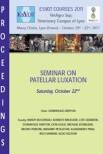The suitability of low-field magnetic resonance (MR) imaging for assessment of articular cartilage has been questioned, based on insufficient image quality. The purposes of this study were to describe the MR anatomy of the normal distal interphalangeal (DIP) cartilage, and to evaluate the sensitivity and accuracy of low-field MR imaging for identification of cartilage erosions that were created ex vivo. Imaging sequences included sagittal and dorsal multiple-oblique T1-weighted gradient-recalled echo (GRE) and sagittal dual echo sequences. In the thickest regions, normal cartilage appeared as a trilaminar structure on high-resolution T1-weighted GRE sequences. All 8 mm large full-thickness erosions were correctly identified (100% sensitivity and accuracy) using T1-weighted GRE sequences. Sensitivity and accuracy ranged from 80% to 100% and 10% to 80%, respectively, for detecting focal full-thickness erosions and from 35% to 80% and 35% to 60%, respectively, for detecting partial thickness erosions, using T1-weighted GRE sequences. Superficial irregularities were not diagnosed using any sequence. Overall, fewer cartilage alterations were detected with sagittal dual echo sequences than with sagittal T1-weighted GRE sequences. The dorsal multiple-oblique plane was useful to detect linear dorsopalmar erosions. A combination of T1-weighted GRE sequences in two planes has potential for identification of severe DIP cartilage erosion in anesthetized horses using low-field MR imaging.
DISTAL INTERPHALANGEAL ARTICULAR CARTILAGE ASSESSMENT USING LOW-FIELD MAGNETIC RESONANCE IMAGING
Date
May/June 2010
Journal
Veterinary Radiology & Ultrasound
Volume
51
Number
3
Pages
259-266









